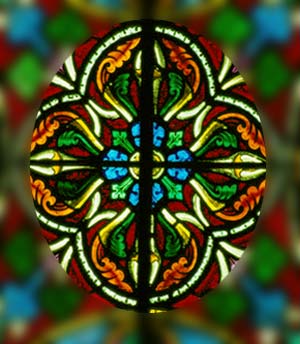Stained Glass Art

Stained glass brings to mind visions of ancient church windows bearing larger than life pictures. These images catch the sun's rays and emerge brilliant and eye-catching! One of the oldest stained glass windows can be seen at the St. Paul's Monastery in Jarrow in England. European cathedrals and Gothic style churches have breathtaking images of stained glass done to minute detail.
Over time stained glass made its foray into items of home décor - lamps, window panels, sun catchers and divider screens. You can use stained glass lamps or door panels to add warmth and richness to the décor. Learn more about the process that goes behind these glass paintings. If you are a stained glass enthusiast, you would do well to check out the various stained glass supply items and kits available today. Find out what faux stained glass is all about. We take you through the annals of history to trace the development of this glass painting process.
Stained Glass Art
Working with glass and creating magic from little intricate bits of glass and infusing life into them with daubs of paint can be extremely rewarding. You can transform sheets of glass into poems of color. This art can also become a lucrative venture, if you are seeking to make a vocation out of it. A brief outline of the process involved in creating attractive stained glass art pieces:
- Choosing and planning a stained glass design is the first step. You can either draw out one yourself or use designs for stained glass painting that can be downloaded from web sites. These designs can then be altered or resized. Designs can range from simple geometric patterns, orchids and other floral schemes to various aspects of nature or even thematic designs.
- Check out various catalogs to choose a glass that is best suited to the pattern as well as the object you are planning to create. You can opt for plain or patterned or translucent or opaque glass.
- The design in then sketched on the glass.
- Each piece of glass has to be painstakingly scored and broken taking care to see that the glass does not break out curves and angles. You can grind down the excess glass and smoothen it with an electric grinder.
- Lay the design on the assembly board and lay the zinc or lead in place. Fix the glass shapes into place and adjust them correctly. Shape the lead came to the required shape. You can use tape to hold the entire stained glass panel in place. Another technique involves using of copper foil in the place of lead came. This foil is placed around the edges of the stained glass pieces. Since the foil is sticky on one side, it adheres to the glass. A beginner to stained glass art would do well to begin with foil and move onto to lead after some practice.
- Finally, the entire panel has to be soldered together. Finally the stained glass art piece has to be waterproofed and cleaned. Finally the lead will emit a soft glow that contrasts wonderfully with the bright glow of the colored glass.
Tips for painting glass
- It is preferable to work on a horizontal surface. Glass droppers are used to pull and blend colors together. The blending must be done when the colors are wet else it will leave brush strokes. When painting stained glass pieces, begin with light colors and blend darker colors into the lighter ones. The skill of a stained glass painter lies in bringing to life various animals, birds and flowers.
- After painting, check for air bubbles, since they must be removed immediately. The time taken for drying depends on the thickness of paint, temperature and humidity.
- When fixing lead came, start at the center and move outwards. You can use antique gold or copper color on the lead came since lead tends to become black on oxidization.
Stained Glass Window
You can opt for stained glass windows at home to add a focal point of beauty within a room. Watch the room take on a different hue and shade as the sun's rays pass through the stained glass. You can overcome an unpleasant view or secure some privacy with stained glass windows. Reduce the intensity of sun's rays into a room with stained glass windows.
Stained Glass Supply
Anyone taking up stained glass art would need adequate supply of materials and tools. If you invest in the right tools, you can use them for many years. While the original method of stained glass painting involves cutting and soldering the design together, the faux stained glass process can be carried out on an existing window.
Typical tools and stained glass supply can be sourced from suppliers of glass painting materials. There are web sites devoted to stained glass painting art that provide a host of services - stained glass patterns that can be downloaded, stained glass items that can be bought as well as ideas and tips on different painting techniques. You would need a glass cutter to cut out various shapes as per your stained glass design.
There is a range of such cutters available. Take the help of your instructor in choosing an appropriate glasscutter or opt for a stained glass kit that offers basic implements and materials. You need a breaker to snap off glass after it has been scored. This works in much the same way as a pair of pliers. A good soldering iron is a good investment if you are planning to make a hobby or home business out of stained glass painting art.
Faux Stained Glass
There are many techniques that are used by artists to create the stained glass effect. The surface of the glass plays an important role in the way the light passes through it and the effect it creates. The classical style of soldered stained glass involves using lead came to join the pieces of glass thereby creating a voluminous stained glass. But this involves considerable effort and time.
It is possible to pick up kits for faux stained glass - ideal for those who do not want to go through the elaborate process of cutting and soldering glass pieces. You can buy readily colored glass. Another technique that makes for effective faux stained glass panels is to use metallic coils or self-adhesive lead. This is applied on top of the glass and the various elements of the design are painted.
Stained Glass Kit
You can pick up a stained glass kit at art stores or online crafts supply sites. These kits provide you with various tools and supplies along with instructions to create a visual kaleidoscope fired by your imagination and creativity. Many of the kits come with pre-cut glass that can simplify the process for you. But those pursuing the craft seriously can opt for stained glass art kits that provide you with solder, soldering iron, glass cutter, pliers, saw and grinder to create panels and other items with precision and quality. Stained glass kits can range from about $90 to $225 in addition to shipping charges.
Stained Glass History
The history of stained glass dates back to the time when glass was developed. Romans and Greeks used mosaic designs made of ceramic glass chips and later evolved into using colored glass sheets and painted glass. European Church windows displayed fine works of stained glass. These stained glass windows served as an expression of faith and to beautify the house of worship. The Renaissance period saw considerable revival of the stained glass art and even to this day, many famous cathedrals and churches bear testimony to it. Louis Tiffany began using stained glass in non-religious forms for windows and lamps.
It was the end of the 1800s that stained glass was used in European chateaux. A shift was seen from the bright colors used in the church windows to soft and milky shades. Opalescent glass and other glass textures were introduced which gave further impetus to the art of stained glass. Today, stained glass as an art form is popularly used in several items of home décor - lampshades, panels, sun catchers and more!
Since the 1960s, stained glass painting gained popularity as a hobby. Many took to attending stained glass workshops and creating their own stained glass items. You can set up a stained glass workshop and take up orders once you are proficient in the process and have a flair for design, color and are deft with your fingers. Give vent to your creativity and start a home business.
Top of the Page: Stained Glass Art
Tags:#glass stained #glass stained window #glass pattern stained #glass stained supply #art glass stained #faux glass stained #glass kit stained #church glass stained window #glass history stained
 Recreation Ideas
Recreation Ideas Needle Crafts
Hobbies - Recreation
Chinese Painting
Travel Accessory
Travel Packing Tip
Basic Survival Skills
Outdoor Survival Skills
Survival Kits
Travel Recreation
Scuba Diving Vacation
Stained Glass Art
Candle Making Tip
Staycation Ideas
Top of the Page: Stained Glass Art
Popularity Index: 101,914

